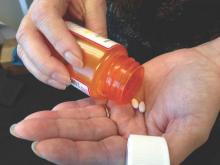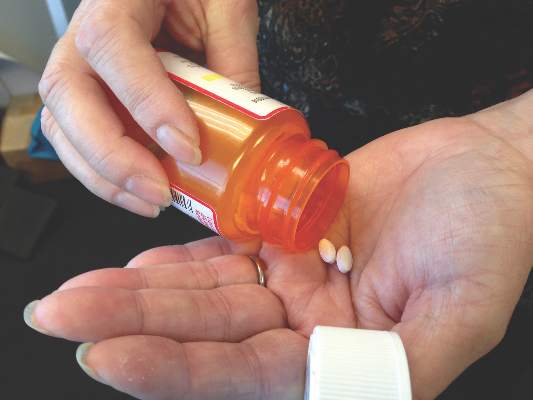User login
SAN DIEGO – Statin use, but not aspirin use, showed a protective effect against pancreatic ductal adenocarcinoma in a large prospective case-control study.
“There also appears to be no chemoenhancing effect from combining the two drugs,” Dr. Livia Archibugi of Hospital Sant’Andrea in Rome, Italy, said at the annual Digestive Disease Week. The study also confirmed known risk factors for pancreatic cancer, “supporting the genuineness of our population,” she and her associates said.
This is the first epidemiologic study to look at both aspirin and statins in relationship to pancreatic cancer. Both types of drugs have shown anticarcinogenic effects in laboratory and epidemiologic studies, Dr. Archibugi noted. For example, aspirin blocks mTOR, NF-kappa B and Wnt signaling, which inhibits carcinogenesis and angiogenesis and promotes apoptosis and DNA mismatch repair. A recent meta-analysis, found a 23% lower risk of pancreatic cancer among aspirin users than nonusers, but the study did not assess concurrent statin use.
Statins, for their part, are both immunomodulatory and anti-inflammatory, and inhibit angiogenesis at low doses, said Dr. Archibugi. However, studies have yielded mixed results about whether they reduce the risk of pancreatic cancer, she noted.
Therefore, between 2005 and 2016, she and her colleagues used questionnaires to study environmental exposures and the family and individual health histories of 408 consecutive patients with pancreatic ductal adenocarcinoma and 816 age- and sex-matched controls. The controls were gastroenterology patients at the same hospital and did not have chronic obstructive pulmonary disease, cirrhosis, chronic kidney failure, acute bleeding, inflammatory bowel disease, or a history of cancer in the past 5 years. The study was large enough to have an 80% power to detect an odds ratio of 0.65 for the relationship between incident pancreatic cancer and either aspirin or statin exposure, and an odds ratio of 0.5 for dual exposure, Dr. Archibugi noted.
Reported statin use was significantly more common among controls (24%) than cases (18%; P = .03), and controls were more likely than cases to report taking either low-dose (less than 20 mg) or high-dose (greater than 20 mg) statins, the investigators found. Proportionally more controls also reported at least a 5-year history of statin use. After controlling for age, sex, and known risk factors, only statin use was significantly associated with incident pancreatic cancer in the multivariate analysis (OR, 0.59; 95% confidence interval, 0.42-0.85; P = .004). The protective effect of statins held up in subgroups stratified by gender, age, and statin type, Dr. Archibugi said.
In contrast, statistically similar proportions of cases (19%) and controls (23%) reported using aspirin, and although aspirin use was inversely linked to incident pancreatic cancer in the univariate analysis, the effect lost significance in the multivariable analysis (OR, 0.78; 95% CI, 0.54-1.11). Moreover, patients who took both aspirin and statins were no less likely to develop pancreatic cancer than those who took only statins.
Like all case-control studies, recall bias could have affected the associations, she noted. However, the same analyses correlated pancreatic cancer with several known risk factors, including smoking (OR, 1.8), heavy drinking (OR, 1.7), diabetes (OR, 1.8), chronic pancreatitis (OR, 14.3), and first-degree family history of pancreatic cancer (OR, 3.1).
Dr. Archibugi and her associates had no disclosures.
SAN DIEGO – Statin use, but not aspirin use, showed a protective effect against pancreatic ductal adenocarcinoma in a large prospective case-control study.
“There also appears to be no chemoenhancing effect from combining the two drugs,” Dr. Livia Archibugi of Hospital Sant’Andrea in Rome, Italy, said at the annual Digestive Disease Week. The study also confirmed known risk factors for pancreatic cancer, “supporting the genuineness of our population,” she and her associates said.
This is the first epidemiologic study to look at both aspirin and statins in relationship to pancreatic cancer. Both types of drugs have shown anticarcinogenic effects in laboratory and epidemiologic studies, Dr. Archibugi noted. For example, aspirin blocks mTOR, NF-kappa B and Wnt signaling, which inhibits carcinogenesis and angiogenesis and promotes apoptosis and DNA mismatch repair. A recent meta-analysis, found a 23% lower risk of pancreatic cancer among aspirin users than nonusers, but the study did not assess concurrent statin use.
Statins, for their part, are both immunomodulatory and anti-inflammatory, and inhibit angiogenesis at low doses, said Dr. Archibugi. However, studies have yielded mixed results about whether they reduce the risk of pancreatic cancer, she noted.
Therefore, between 2005 and 2016, she and her colleagues used questionnaires to study environmental exposures and the family and individual health histories of 408 consecutive patients with pancreatic ductal adenocarcinoma and 816 age- and sex-matched controls. The controls were gastroenterology patients at the same hospital and did not have chronic obstructive pulmonary disease, cirrhosis, chronic kidney failure, acute bleeding, inflammatory bowel disease, or a history of cancer in the past 5 years. The study was large enough to have an 80% power to detect an odds ratio of 0.65 for the relationship between incident pancreatic cancer and either aspirin or statin exposure, and an odds ratio of 0.5 for dual exposure, Dr. Archibugi noted.
Reported statin use was significantly more common among controls (24%) than cases (18%; P = .03), and controls were more likely than cases to report taking either low-dose (less than 20 mg) or high-dose (greater than 20 mg) statins, the investigators found. Proportionally more controls also reported at least a 5-year history of statin use. After controlling for age, sex, and known risk factors, only statin use was significantly associated with incident pancreatic cancer in the multivariate analysis (OR, 0.59; 95% confidence interval, 0.42-0.85; P = .004). The protective effect of statins held up in subgroups stratified by gender, age, and statin type, Dr. Archibugi said.
In contrast, statistically similar proportions of cases (19%) and controls (23%) reported using aspirin, and although aspirin use was inversely linked to incident pancreatic cancer in the univariate analysis, the effect lost significance in the multivariable analysis (OR, 0.78; 95% CI, 0.54-1.11). Moreover, patients who took both aspirin and statins were no less likely to develop pancreatic cancer than those who took only statins.
Like all case-control studies, recall bias could have affected the associations, she noted. However, the same analyses correlated pancreatic cancer with several known risk factors, including smoking (OR, 1.8), heavy drinking (OR, 1.7), diabetes (OR, 1.8), chronic pancreatitis (OR, 14.3), and first-degree family history of pancreatic cancer (OR, 3.1).
Dr. Archibugi and her associates had no disclosures.
SAN DIEGO – Statin use, but not aspirin use, showed a protective effect against pancreatic ductal adenocarcinoma in a large prospective case-control study.
“There also appears to be no chemoenhancing effect from combining the two drugs,” Dr. Livia Archibugi of Hospital Sant’Andrea in Rome, Italy, said at the annual Digestive Disease Week. The study also confirmed known risk factors for pancreatic cancer, “supporting the genuineness of our population,” she and her associates said.
This is the first epidemiologic study to look at both aspirin and statins in relationship to pancreatic cancer. Both types of drugs have shown anticarcinogenic effects in laboratory and epidemiologic studies, Dr. Archibugi noted. For example, aspirin blocks mTOR, NF-kappa B and Wnt signaling, which inhibits carcinogenesis and angiogenesis and promotes apoptosis and DNA mismatch repair. A recent meta-analysis, found a 23% lower risk of pancreatic cancer among aspirin users than nonusers, but the study did not assess concurrent statin use.
Statins, for their part, are both immunomodulatory and anti-inflammatory, and inhibit angiogenesis at low doses, said Dr. Archibugi. However, studies have yielded mixed results about whether they reduce the risk of pancreatic cancer, she noted.
Therefore, between 2005 and 2016, she and her colleagues used questionnaires to study environmental exposures and the family and individual health histories of 408 consecutive patients with pancreatic ductal adenocarcinoma and 816 age- and sex-matched controls. The controls were gastroenterology patients at the same hospital and did not have chronic obstructive pulmonary disease, cirrhosis, chronic kidney failure, acute bleeding, inflammatory bowel disease, or a history of cancer in the past 5 years. The study was large enough to have an 80% power to detect an odds ratio of 0.65 for the relationship between incident pancreatic cancer and either aspirin or statin exposure, and an odds ratio of 0.5 for dual exposure, Dr. Archibugi noted.
Reported statin use was significantly more common among controls (24%) than cases (18%; P = .03), and controls were more likely than cases to report taking either low-dose (less than 20 mg) or high-dose (greater than 20 mg) statins, the investigators found. Proportionally more controls also reported at least a 5-year history of statin use. After controlling for age, sex, and known risk factors, only statin use was significantly associated with incident pancreatic cancer in the multivariate analysis (OR, 0.59; 95% confidence interval, 0.42-0.85; P = .004). The protective effect of statins held up in subgroups stratified by gender, age, and statin type, Dr. Archibugi said.
In contrast, statistically similar proportions of cases (19%) and controls (23%) reported using aspirin, and although aspirin use was inversely linked to incident pancreatic cancer in the univariate analysis, the effect lost significance in the multivariable analysis (OR, 0.78; 95% CI, 0.54-1.11). Moreover, patients who took both aspirin and statins were no less likely to develop pancreatic cancer than those who took only statins.
Like all case-control studies, recall bias could have affected the associations, she noted. However, the same analyses correlated pancreatic cancer with several known risk factors, including smoking (OR, 1.8), heavy drinking (OR, 1.7), diabetes (OR, 1.8), chronic pancreatitis (OR, 14.3), and first-degree family history of pancreatic cancer (OR, 3.1).
Dr. Archibugi and her associates had no disclosures.
AT DDW® 2016
Key clinical point: Statin use was linked to lower odds of pancreatic ductal adenocarcinoma, while aspirin use was not.
Major finding: Statin use was the only statistically significant protective factor in the multivariate analysis, with an adjusted OR of 0.59 (P = .004).
Data source: A prospective case-control study of 408 patients with pancreatic cancer and 816 age- and sex-matched hospital controls.
Disclosures: Dr. Archibugi and her associates had no disclosures.

